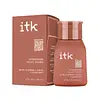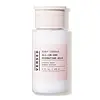What's inside
What's inside
 Key Ingredients
Key Ingredients

 Benefits
Benefits

 Concerns
Concerns

 Ingredients Side-by-side
Ingredients Side-by-side

Water
Skin ConditioningSqualane
EmollientPropanediol
SolventGlycereth-26
HumectantPolysorbate 80
Emulsifying1,2-Hexanediol
Skin ConditioningStyrene/Acrylates Copolymer
Caprylhydroxamic Acid
Lauryl Glucoside
CleansingPolyglyceryl-2 Dipolyhydroxystearate
Skin ConditioningCitric Acid
BufferingAcrylates/C10-30 Alkyl Acrylate Crosspolymer
Emulsion StabilisingAvena Sativa Kernel Flour
AbrasiveGlycerin
HumectantXanthan Gum
EmulsifyingSodium Hydroxide
BufferingCoco-Glucoside
CleansingTrisodium Ethylenediamine Disuccinate
Sodium Hyaluronate
HumectantBenzoic Acid
MaskingCamellia Sinensis Leaf Extract
AntimicrobialPhenoxyethanol
PreservativeWater, Squalane, Propanediol, Glycereth-26, Polysorbate 80, 1,2-Hexanediol, Styrene/Acrylates Copolymer, Caprylhydroxamic Acid, Lauryl Glucoside, Polyglyceryl-2 Dipolyhydroxystearate, Citric Acid, Acrylates/C10-30 Alkyl Acrylate Crosspolymer, Avena Sativa Kernel Flour, Glycerin, Xanthan Gum, Sodium Hydroxide, Coco-Glucoside, Trisodium Ethylenediamine Disuccinate, Sodium Hyaluronate, Benzoic Acid, Camellia Sinensis Leaf Extract, Phenoxyethanol
Water
Skin ConditioningPropanediol
SolventCocos Nucifera Water
MaskingGlycerin
HumectantCetearyl Isononanoate
EmollientDicaprylyl Carbonate
EmollientPolyglyceryl-10 Oleate
Skin ConditioningPhyllostachys Bambusoides Leaf Extract
Skin ConditioningAlgae Extract
EmollientLeuconostoc/Radish Root Ferment Filtrate
AntimicrobialTocopheryl Acetate
AntioxidantPolyglyceryl-2 Oleate
EmulsifyingPhenoxyethanol
PreservativeEthylhexylglycerin
Skin ConditioningDisodium EDTA
Xanthan Gum
EmulsifyingWater, Propanediol, Cocos Nucifera Water, Glycerin, Cetearyl Isononanoate, Dicaprylyl Carbonate, Polyglyceryl-10 Oleate, Phyllostachys Bambusoides Leaf Extract, Algae Extract, Leuconostoc/Radish Root Ferment Filtrate, Tocopheryl Acetate, Polyglyceryl-2 Oleate, Phenoxyethanol, Ethylhexylglycerin, Disodium EDTA, Xanthan Gum
 Reviews
Reviews

Ingredients Explained
These ingredients are found in both products.
Ingredients higher up in an ingredient list are typically present in a larger amount.
Glycerin is already naturally found in your skin. It helps moisturize and protect your skin.
A study from 2016 found glycerin to be more effective as a humectant than AHAs and hyaluronic acid.
As a humectant, it helps the skin stay hydrated by pulling moisture to your skin. The low molecular weight of glycerin allows it to pull moisture into the deeper layers of your skin.
Hydrated skin improves your skin barrier; Your skin barrier helps protect against irritants and bacteria.
Glycerin has also been found to have antimicrobial and antiviral properties. Due to these properties, glycerin is often used in wound and burn treatments.
In cosmetics, glycerin is usually derived from plants such as soybean or palm. However, it can also be sourced from animals, such as tallow or animal fat.
This ingredient is organic, colorless, odorless, and non-toxic.
Glycerin is the name for this ingredient in American English. British English uses Glycerol/Glycerine.
Learn more about GlycerinPhenoxyethanol is a preservative that has germicide, antimicrobial, and aromatic properties. Studies show that phenoxyethanol can prevent microbial growth. By itself, it has a scent that is similar to that of a rose.
It's often used in formulations along with Caprylyl Glycol to preserve the shelf life of products.
Propanediol is an all-star ingredient. It softens, hydrates, and smooths the skin.
It’s often used to:
Propanediol is not likely to cause sensitivity and considered safe to use. It is derived from corn or petroleum with a clear color and no scent.
Learn more about PropanediolWater. It's the most common cosmetic ingredient of all. You'll usually see it at the top of ingredient lists, meaning that it makes up the largest part of the product.
So why is it so popular? Water most often acts as a solvent - this means that it helps dissolve other ingredients into the formulation.
You'll also recognize water as that liquid we all need to stay alive. If you see this, drink a glass of water. Stay hydrated!
Learn more about WaterXanthan gum is used as a stabilizer and thickener within cosmetic products. It helps give products a sticky, thick feeling - preventing them from being too runny.
On the technical side of things, xanthan gum is a polysaccharide - a combination consisting of multiple sugar molecules bonded together.
Xanthan gum is a pretty common and great ingredient. It is a natural, non-toxic, non-irritating ingredient that is also commonly used in food products.
Learn more about Xanthan Gum